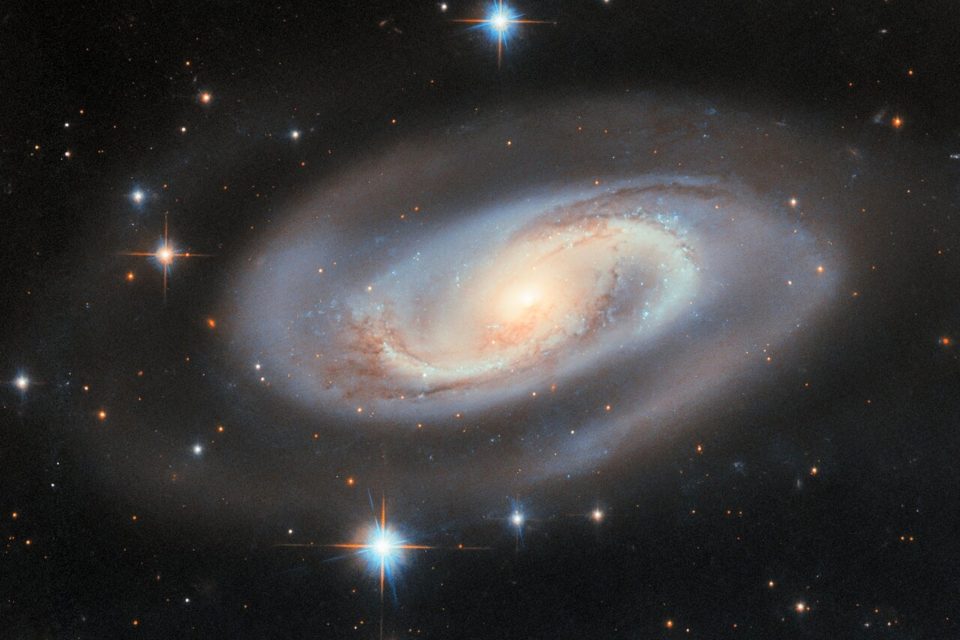Hubble reveals a galaxy feeding its black hole
Today’s Image of the Day from the European Space Agency features the spiral galaxy UGC 11397 in the constellation Lyra (The Lyre).
The light captured in this striking image traveled for 250 million years before reaching the NASA/ESA Hubble Space Telescope.
What reached Hubble’s lens is not just a breathtaking image of stars and dust, but a glimpse into one of the universe’s most powerful engines – a growing supermassive black hole.
“At first glance, UGC 11397 appears to be an average spiral galaxy: it sports two graceful spiral arms that are illuminated by stars and defined by dark, clumpy clouds of dust,” noted ESA.
“What sets UGC 11397 apart from a typical spiral lies at its center, where a supermassive black hole containing 174 million times the mass of the Sun is growing.”
A hidden powerhouse
As the black hole consumes gas, dust, and even entire stars from its surroundings, the infalling material heats up dramatically, producing a dazzling display of energy.
These emissions span the electromagnetic spectrum – from gamma rays to radio waves – and can flare or fade unpredictably.
“But in some galaxies, including UGC 11397, thick clouds of dust hide much of this energetic activity from view in optical light,” explained ESA.
“Despite this, UGC 11397’s actively growing black hole was revealed through its bright X-ray emission – high-energy light that can pierce the surrounding dust.”
Its distinctive signature has earned UGC 11397 the classification of a Type 2 Seyfert galaxy. This category describes active galaxies whose central regions are obscured in visible light by a doughnut-shaped cloud of dust and gas.
Galaxy and black hole growth
“Using Hubble, researchers will study hundreds of galaxies that, like UGC 11397, harbor a supermassive black hole that is gaining mass,” noted ESA.
“The Hubble observations will help researchers weigh nearby supermassive black holes, understand how black holes grew early in the universe’s history, and even study how stars form in the extreme environment found at the very center of a galaxy.”
Studying galaxies like UGC 11397 also offers insight into the mysterious relationship between supermassive black holes and their host galaxies.
Despite residing at the heart of galaxies, these black holes influence their surroundings on a much larger scale.
Black holes often regulate the formation of stars and can even shape the structure of the galaxy itself.
Tracing black hole origins
One of the key questions astronomers hope to answer is how these black holes grow so massive in the first place.
While some appear to have formed gradually over billions of years, others – especially those in the early universe – seem to have reached enormous sizes much more quickly.
Observations of galaxies such as UGC 11397 provide crucial data to test different growth scenarios.
A clearer picture of cosmic evolution
By combining Hubble’s observations with data from other telescopes, including those that detect X-rays and radio waves, researchers can build a more complete picture of how matter behaves around black holes.
This multi-wavelength approach is essential for studying objects obscured by dust, like Type 2 Seyfert galaxies, where optical views alone can be misleading.
Hubble’s sharp vision also allows astronomers to examine the surrounding galactic disk and spiral arms in high detail.
These structures hold clues about recent star formation, galactic dynamics, and how gas flows toward the center – fueling both star birth and black hole growth.
Black hole energy in active galaxies
In many active galaxies, the energy released by the central black hole can blast out powerful winds or jets that affect star formation. These feedback processes can either shut down or stimulate the creation of new stars, depending on the conditions.
Understanding when and how this feedback occurs is another major goal of Hubble’s ongoing studies.
UGC 11397 is just one of many galaxies being surveyed as part of broader efforts to trace the cosmic history of black hole activity.
Models of galaxy evolution
Projects such as these are helping scientists map how common active galactic nuclei are, how their properties evolve over time, and how they relate to galaxy mergers and other large-scale events.
The wealth of information gathered from galaxies like UGC 11397 is not only deepening our understanding of black holes but also refining models of galaxy formation and evolution.
With each new observation, astronomers are piecing together the vast and complex puzzle of how galaxies and their central engines co-evolve across cosmic time.
Image Credit: ESA/Hubble & NASA, M. J. Koss, A. J. Barth
—–
Like what you read? Subscribe to our newsletter for engaging articles, exclusive content, and the latest updates.
Check us out on EarthSnap, a free app brought to you by Eric Ralls and Earth.com.
—–




















